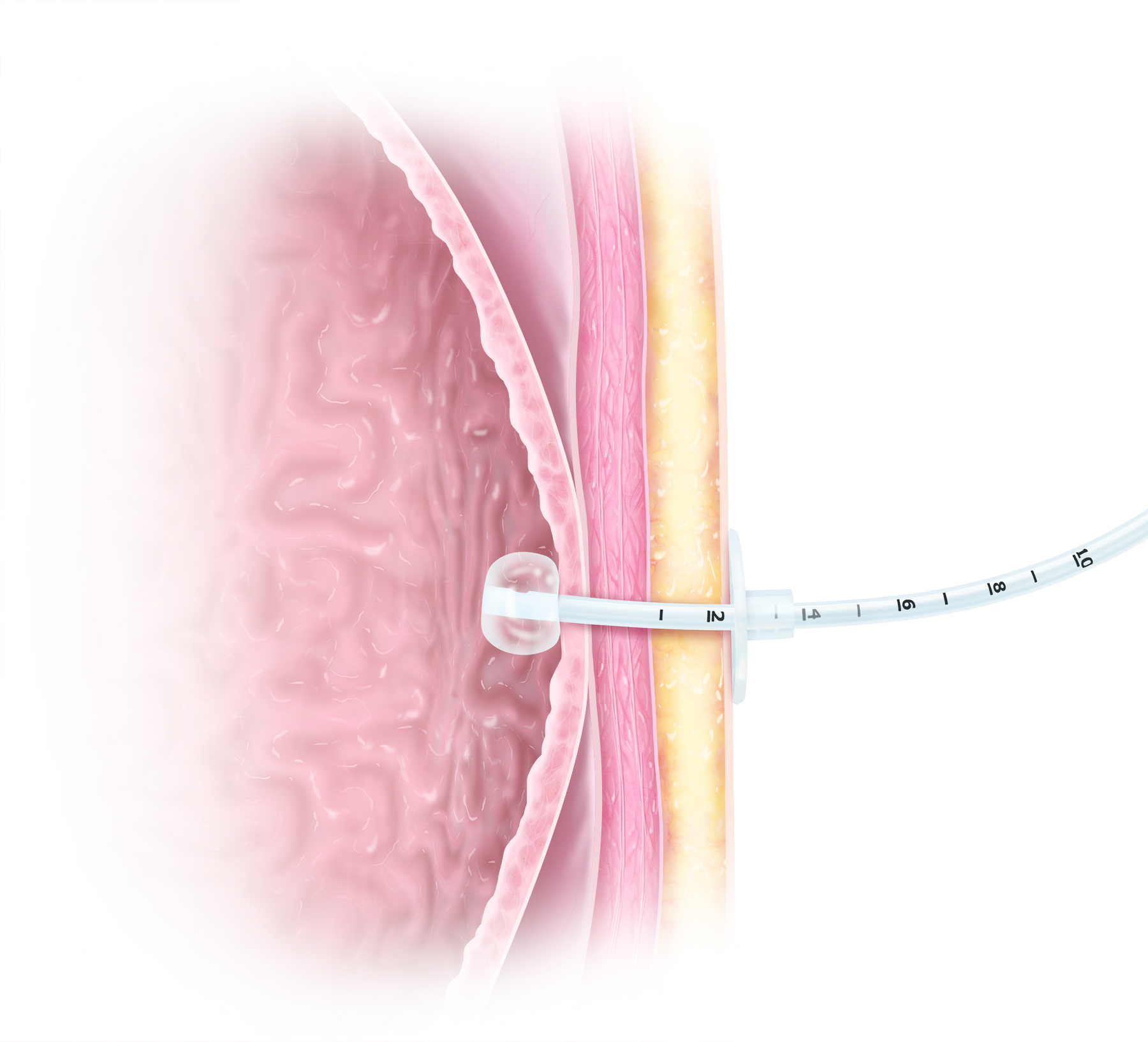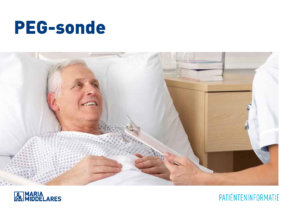PEG tube

What is it?
What is it?PEG stands for Percutaneous Endoscopic Gastrostomy. A PEG tube is a little tube that connects the outside world and the stomach. This replaces the way food normally transits from the mouth to the stomach. The PEG tube can be used to give water, food and (sometimes) medications. The tube stays in place using either an internal or external fixation device.
What is the procedure like?
What is the procedure like?The PEG tube is placed using a short-acting general anaesthesia. A gastroscope (a flexible tube) is inserted into the mouth and then into the oesophagus, stomach and the start of the duodenum to inspect these areas. If a good place in the stomach is located, a very small opening is made in the abdominal wall, into which the PEG tube can directed to the outside. The procedure takes about 30 minutes.
Aftercare
AftercareThe (home) nurse will take care of the daily care for the first couple of days and will carefully inspect the skin around the tube.
The first ten days
Daily checks are required to see whether the tube is securely affixed and to make sure there is not a lot of movement between the tube and the skin. In addition, the bandage and the skin are inspected. If the bandage is moist or if the skin around the insertion site looks red, then the bandage will be replaced and the sking around the insertion site will be disinfected with a watery disinfection agent. Afterwards, it will be checked to see if there is good fixation with the skin. It is normal for there to be light-pink fluid discharge during the first few days from around the insertion site.
Afterwards
- Once the insertion site is properly healed, then you may take over your care.
- The skin around the insertion site should be washed everyday with water and soap, and then rinsed and dried. You may cover it with a bandage, but this is not necessary. The skin at the insertion site will be more sensitive than the skin around it. This is completely normal. You should inspect the skin at the insertion site daily. If you notice redness, swelling, and/or any greenish-yellow discharge (this is a sign of infection, and is often accompanied by fever), or if the insertion site is very painful, please contact your GP.
- The tube needs to be rinsed daily with at least 50 ml of water, even if it is not used. The PEG tube also needs to be rinsed after every tube feeding and before every time medications are administered, without fail.
- The PEG tube must be ‘dipped’ daily. This prevents the PEG tube's internal fixation device from growing into the stomach wall. The cover plate is loosened, the tube is pushed a bit deeper in and then turned 360 degrees. The nurse or home health nurse will show you how to do this confidently. ‘Dipping’ should not be happen if the insertion site is not yet completely healed (definitely not during the first ten days after the placement of the PEG tube).
DIPPING = moving the PEG tube back and forth
- Take care that the feeding clamp is closed completely.
- Loosen the PEG tube from the external fixation device.
- Move the external fixation plate so that it is a few centimenters away from the skin and then remember where the external fixation plate was on the tube.
- Hold the PEG tube with your thumb and index finger and push it about three centimeters inside. Pull again towards the outside. Move the tube in this way, back and forth, a few times. The PEG tube may also be turned and swiveled as you do this.
- Finally, pull the PEG tube towards the outside and then place the external fixation plate against the abdominal wall. Take care to leave some slack, about two mm. This is important for preventing any leakage.
Using the PEG tube
Using the PEG tubeThe earliest you may use the PEG tube is after six to eight hours after placement. You should nevere give medications at the same time as you administer feeding through the tube.
Removing the PEG tube
Removing the PEG tubeIf the PEG tube is no longer necessary (e.g. if you are able to eat by mouth again), then it may be decided to remove the PEG tube. This procedure is performed under general anaesthesia or narcosis, or after receiving local anaesthesia in the throat.
You will need to be fasting for six hours before the procedure. This means that you may not eat or drink or smoking, and that you may not receive any feeding via the tube. Medications not given for this reason will be administered as normal after the procedure. If you have dentures, you will be asked to remove them before the procedure.
The PEG tube will then be removed with a gastroscope. The insertion site will close spontaneously within 24 hours. It will be covered completely wtih a bandage during the recovery period.
Leaflet
LeafletThe leaflet below provides more information about the PEG tube, the PEG-J tube and the balloon tube.
Only available in Dutch:

PEG-sonde
DownloadCentres and specialist areas
Centres and specialist areas
Something wrong or unclear on this page? Report it.
Latest publication date: 13/08/2024
Supervising author: Dr. Monsaert Els





